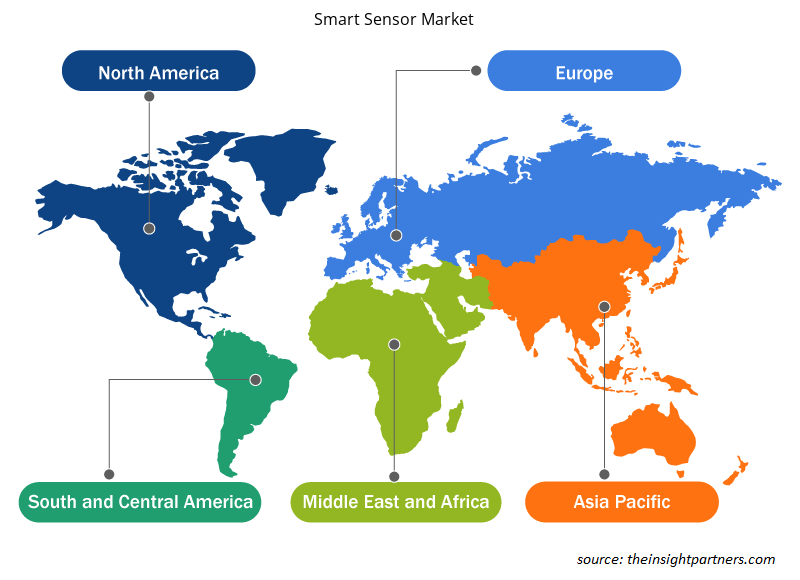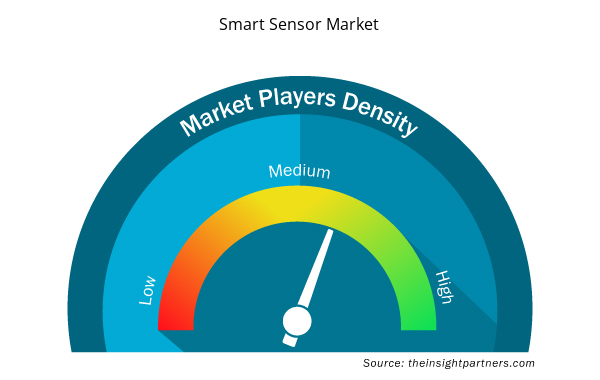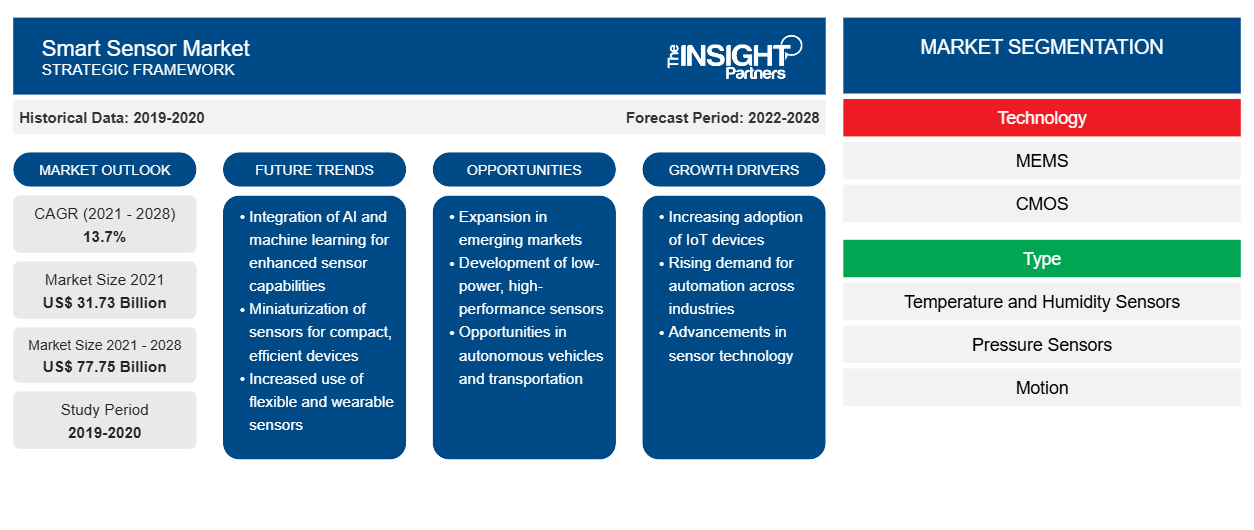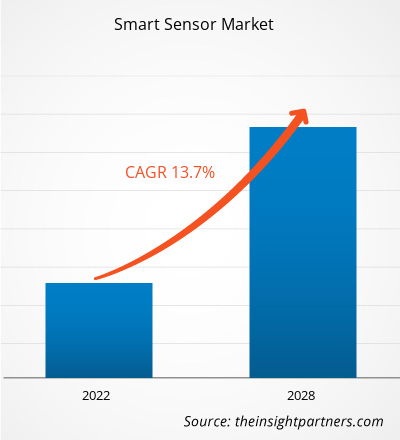스마트 센서 시장은 2021년 31,731.1백만 달러에서 2028년 77,747.6백만 달러로 성장할 것으로 예상됩니다. 2021년에서 2028년 사이에 13.7%의 CAGR로 성장할 것으로 추산됩니다.
스마트 센서는 기존 센서보다 빠르고 정확합니다. 이러한 센서는 기존 센서보다 작고 전력 소모가 적습니다. IoT 기반 장치 및 가전제품에서 스마트 센서 기술을 사용하고 항공우주 및 방위, 자동차, 생물의학 및 헬스케어, 산업 자동화, 빌딩 자동화, 가전제품, 교육, 로봇공학, 농업 및 운송 산업에 적용하는 것은 지난 몇 년 동안 많은 관심을 끌었습니다. 모든 애플리케이션에서 스마트 센서 사용이 증가하는 것은 스마트 센서 시장 규모를 확대하는 핵심 요인입니다.
안전 및 보안에 대한 우려가 커지면서 가전제품의 스마트 센서에 대한 수요가 증가하면서 스마트 센서 시장에 영향을 미치고 있습니다. 야간 투시 IR 센서, 사운드 센서 또는 마이크 , 스마트 변기와 같은 다양한 센서가 홈 오토메이션에 사용됩니다. 회사는 자동 세척, 자동 플러싱, 탱크 누출 모니터링, 물 넘침 방지 및 건강 모니터링과 같은 다양한 기능을 스마트 센서에 통합합니다. 조명과 팬은 적외선 또는 모션 센서를 사용하는 자동 시스템으로 제어할 수 있습니다.
또한, 변화하는 라이프스타일과 새로운 현대적 생활 수준에 따라 홈 오토메이션과 통합된 모듈식 주방에 대한 수요가 기하급수적으로 증가하고 있으며, 이는 스마트 센서 시장에 긍정적인 영향을 미치고 있습니다. 제조업체는 진동, 주방 소리, 빛, 가스, 온도, 열, 전자기 온도 및 소음을 모니터링하는 합성 센서 기반 장치를 개발하고 있으며, 스마트 센서 시장 규모를 확대하고 있습니다. 예를 들어, Analog Devices, Inc.는 HMC1126 GaAs pHEMT 센서를 제공합니다. 이 제품은 400MHz~52GHz 범위에서 작동하는 저잡음 증폭기로, 마이크로파 라디오, 초소형 개구 단자(VSAT), 테스트 장비, 5G 통신 등 여러 애플리케이션에 사용됩니다.
귀하의 요구 사항에 맞게 이 보고서를 사용자 정의하세요
이 보고서의 일부 또는 국가 수준 분석, Excel 데이터 팩을 포함하여 모든 보고서에 대한 사용자 정의를 무료로 받을 수 있으며 신생 기업 및 대학을 위한 훌륭한 혜택과 할인 혜택을 이용할 수 있습니다.
- 이 보고서의 주요 시장 동향을 알아보세요.이 무료 샘플에는 시장 동향부터 추정 및 예측까지 다양한 데이터 분석이 포함됩니다.
스마트 센서 기술은 스마트폰과 웨어러블 기기의 급속한 기술 발전을 가져왔습니다. 자동차 제조업체는 안전과 편안함을 개선하기 위해 스마트 센서를 점점 더 요구하고 있습니다. 스마트 센서가 장착된 보안 장치를 모니터링하고 제어하기 위해 무선 기술을 사용하는 것이 점점 더 일반화되고 있습니다. COVID-19 속에서 스마트 센서 지원 웨어러블 기기에 대한 수요 급증, 친환경 건물 건설에 대한 지속적인 정부 지원, 예측 유지 관리가 스마트 센서 시장 참여자에게 수익성 있는 기회를 제공하고 있습니다.
스마트폰 보급률의 증가는 스마트 센서 시장 성장을 상당히 촉진해 왔습니다. 스마트 센서에는 모션, 위치, 주변광, 가속도계, 자이로스코프 와 같은 인기 있는 센서가 포함됩니다 . SAR(Specific Absorption Rate) 센서는 스마트폰, 태블릿, 노트북의 5G sub-6/4G/Wi-Fi와 같은 광범위한 무선 기술의 연결성을 향상시킵니다. 선도적인 반도체 공급업체인 SEMTECH는 스마트폰, 노트북, 태블릿, 웨어러블과 같은 다양한 애플리케이션에 사용할 수 있는 PerSeTM Connect, PerSe Connect Pro, PerSe Control 센서를 제공합니다.
많은 회사가 마이크로컨트롤러를 단일 패키지로 결합한 새롭고 진보된 스마트 센서를 개발하고 있습니다. AI(인공지능) 및 IoT와 같은 최신 기술은 작은 패키지 내에서 이러한 결합을 가능하게 합니다. 예를 들어, Bosch Sensortec의 BHA250은 2.2 x 2.2 x 0.95 mm3 패키지에서 32비트 마이크로컨트롤러와 14비트 가속 센서를 결합할 수 있습니다. 또한 TE Connectivity 회사는 기능을 작은 공간에 담기 위해 커넥터와 센서를 통합했습니다. 스마트 센서 기술의 이러한 발전은 스마트 센서 시장 성장에 긍정적인 영향을 미치고 있습니다. 스마트 음료 자동판매기, 스마트 홈 자동화 시스템, 간단한 컴퓨터, 디지털 보조 장치(예: Alexa), 인간 착용형 기기와 같은 소비자 전자 산업의 성장으로 스마트 센서 시장에서 스마트 센서에 대한 수요가 증가했습니다. 노트북, 스마트폰, TV와 같은 기존 소비자 제품은 소비자가 웨어러블, 음성 인식 스마트 스피커, 스마트 홈 기기를 포함한 새롭고 떠오르는 제품을 계속 채택함에 따라 기대치를 계속 뛰어넘고 있습니다.
여러 연구에 따르면, 앞으로 몇 년 안에 수천억 개의 IoT 기기가 인터넷에 연결될 것이며, 이는 스마트 센서 시장에 큰 영향을 미칠 것입니다. COVID-19는 도시 정부가 새로운 현실에 적응함에 따라 도시 회복력과 디지털 변환 전략 의제를 추진하고 있습니다.
COVID-19 팬데믹이 스마트 센서 시장에 미치는 영향
COVID-19의 출현으로 원격 환자 모니터링을 위한 디지털 인프라를 활용하고 활용할 필요성이 날카롭게 부각되었습니다. 현재 바이러스 검사 및 백신의 개발이 느리기 때문에 개인 및 인구 건강에 대한 보다 강력한 질병 탐지 및 모니터링에 대한 필요성이 더 크다는 것이 확인되었으며, 웨어러블 센서가 이를 도울 수 있습니다. 이 기술의 유용성은 생리적 지표를 일상 생활 및 인간 성과와 상관시키는 데 사용되었지만, COVID-19의 발생을 예측하는 데 적용하는 것이 여전히 필요합니다.
에너지 절약 장치에 대한 수요가 증가함에 따라 북미 스마트 센서 시장에서 스마트 센서에 대한 시장 수요가 증가하고 있습니다. 변화하는 시나리오가 에너지 효율적인 장비와 제품을 필요로 하기 때문에 기업들은 에너지 효율적인 에너지 절약 장비로 전환하고 있습니다. 또한, 스마트 센서 시장에서의 센서 수요는 정부의 엄격한 규제가 해제되면서 다양한 산업에서 증가했으며, 이는 자동화 산업에서 인기를 얻고 있습니다. 또한 자동차 부문의 센서 수요는 자동차의 평균 중량을 줄이려는 욕구에 의해 주도되고 있습니다. 경량 자동차는 연료 효율성과 에너지 최적화에 모두 도움이 됩니다.
스마트 센서 시장 지역 통찰력
Insight Partners의 분석가들은 예측 기간 동안 스마트 센서 시장에 영향을 미치는 지역적 추세와 요인을 철저히 설명했습니다. 이 섹션에서는 북미, 유럽, 아시아 태평양, 중동 및 아프리카, 남미 및 중미의 스마트 센서 시장 세그먼트와 지리에 대해서도 설명합니다.

- 스마트 센서 시장을 위한 지역별 데이터 얻기
스마트 센서 시장 보고서 범위
| 보고서 속성 | 세부 |
|---|---|
| 2021년 시장 규모 | 317억 3천만 달러 |
| 2028년까지 시장 규모 | 777억 5천만 달러 |
| 글로벌 CAGR (2021-2028) | 13.7% |
| 역사적 데이터 | 2019-2020 |
| 예측 기간 | 2022-2028 |
| 다루는 세그먼트 | 기술로
|
| 포함된 지역 및 국가 | 북아메리카
|
| 시장 선도 기업 및 주요 회사 프로필 |
|
시장 참여자 밀도: 비즈니스 역학에 미치는 영향 이해
스마트 센서 시장 시장은 소비자 선호도의 변화, 기술 발전, 제품의 이점에 대한 인식 증가와 같은 요인으로 인해 최종 사용자 수요가 증가함에 따라 빠르게 성장하고 있습니다. 수요가 증가함에 따라 기업은 제품을 확장하고, 소비자의 요구를 충족하기 위해 혁신하고, 새로운 트렌드를 활용하여 시장 성장을 더욱 촉진하고 있습니다.
시장 참여자 밀도는 특정 시장이나 산업 내에서 운영되는 회사나 기업의 분포를 말합니다. 주어진 시장 공간에 얼마나 많은 경쟁자(시장 참여자)가 존재하는지 그 규모나 전체 시장 가치에 비해 나타냅니다.
스마트 센서 시장에서 활동하는 주요 회사는 다음과 같습니다.
- 아날로그 디바이스 주식회사
- 인피니언 테크놀로지스 주식회사
- ST마이크로일렉트로닉스
- TE 커넥티비티
- 마이크로칩 테크놀로지
면책 조항 : 위에 나열된 회사는 어떤 특별한 순서에 따라 순위가 매겨지지 않았습니다.

- 스마트 센서 시장의 주요 기업 개요를 알아보세요
스마트 센서 시장 세분화
기술에 따라 스마트 센서 시장은 MEMS, CMOS 및 기타로 세분화됩니다. 2021년에는 MEMS 세그먼트가 시장을 주도했습니다. 유형에 따라 스마트 센서 시장은 온도 및 습도 센서, 압력 센서, 모션 센서, 위치 센서 및 기타로 세분화됩니다. 2021년에는 온도 및 습도 센서 세그먼트가 가장 큰 시장 점유율을 차지했습니다. 최종 사용 산업에 따라 스마트 센서 시장은 가전 제품, 자동차, 의료, 제조, 소매 및 기타로 세분화됩니다.
Analog Devices Inc., Infineon Technologies Inc., STMicroelectronics, TE Connectivity, Microchip Technologies, NXP Semiconductor, Siemens AG, ABB Ltd., Robert Bosch GmbH, Honeywell International은 주요 스마트 센서 시장 참여자 중 일부입니다. 이 외에도 글로벌 스마트 센서 시장의 전반적인 역학을 이해하기 위해 여러 다른 참여자를 분석했습니다.
- 역사적 분석(2년), 기준 연도, CAGR을 포함한 예측(7년)
- PEST 및 SWOT 분석
- 시장 규모 가치/양 - 글로벌, 지역, 국가
- 산업 및 경쟁 환경
- Excel 데이터 세트


- Architecture Software Market
- Drain Cleaning Equipment Market
- Fish Protein Hydrolysate Market
- Medical Collagen Market
- Passport Reader Market
- Redistribution Layer Material Market
- Print Management Software Market
- Advanced Planning and Scheduling Software Market
- Microcatheters Market
- Cell Line Development Market

Report Coverage
Revenue forecast, Company Analysis, Industry landscape, Growth factors, and Trends

Segment Covered
This text is related
to segments covered.

Regional Scope
North America, Europe, Asia Pacific, Middle East & Africa, South & Central America

Country Scope
This text is related
to country scope.
자주 묻는 질문
The Internet of Things (IoT) has accelerated the evolution of sensors to new heights. With the industry 4.0-powered cyber-physical transformation of manufacturing industries, many production facilities are taking up smart sensors. IoT platforms use a variety of sensors to deliver intelligence and data, allowing devices to function autonomously and the entire ecosystem to become more intelligent. Devices share information and improve their efficiency and functionality by combining a set of sensors and a communication network. The demand for IoT is growing in various industrial verticals, which, in turn, is supporting the growth of the smart sensor market.
In 2021, the market for temperature & humidity sensors held the largest market share. The demand for dependable, high-performance, low-cost sensors is growing, fueling the development of new technologies such as micro-and nanotechnology. Stick-on or printed sensors can be attached to equipment as labels to measure physical factors such as humidity, temperature, and gas pressure. Because of their inexpensive cost, compact size, and ease of use, the sensors are widely used in various sectors, including automobiles, homes, medical devices, the environment, food processing, and chemical. A temperature sensor's primary application is in a smart thermostat, a smart home device. Because of significant consumer interest, incremental technology breakthroughs, and increased accessibility, the total market for smart homes is expected to expand fast. Analog Devices, Inc., STMicroelectronics, TE Connectivity Corporation, Microchip Technology Inc., NXP Semiconductors, and other firms provide a wide range of temperature and humidity sensors to the global market.
MEMS is expected to dominate the smart sensor market during the forecast period. MEMS uses small miniaturized electromechanical and mechanical systems of actuators, sensors, and microelectronics. This technology is expected to continue to dominate the market for smart sensors in the coming years and to be the fastest-growing technology during the forecast period, owing to the numerous benefits it provides, including fast operations, high reliability, improved accuracy, easy maintenance, and replacement, and low energy and material consumption. This technology enables the sensor to perform intelligently by allowing them to store a significant quantity of data in the blink of an eye. The typical data obtained by the sensor is processed by the microprocessor, which erases or saves the data based on an advanced computation. The primary benefits of MEMS technology are reduced energy and material consumption, higher repeatability, increased accuracy, and increased sensitivity and selectivity. The MEMS segment is expected to have the most significant CAGR during the anticipated period. It is due to the increased use of IoT and wearable devices such as smartwatches. Smartwatches include tiny sensors, which contributes to an increase in the demand for MEMS technology for use in these devices. As a result, rising sales of smartwatches are likely to increase demand for MEMS technology throughout the forecasted period. Furthermore, the growing preference for smart homes would fuel the need for MEMS technology throughout the forecast period.
Many automotive manufacturers are coming up with new intelligent vehicles. They are more inclined toward cutting-edge smart sensors. APAC is expected to be the most important market for smart sensors vendors over the coming years in the automotive, infrastructure, consumer electronics, and pharmaceuticals industries, with China, India, and Japan demonstrating a significantly high demand. As the global manufacturing hub for various industries, including semiconductor and automotive, which produce home appliances, smartphones, computers, and peripheral devices, China's manufacturing sector has seen massive growth over the last few years. As a result, an enormous increase in the production and sale of sensing devices can be seen in this region. Long-range low-power wide-area network (LPWAN) technologies, such as NB-IoT, LoRa, LTE-M, and Sigfox, are fueling IoT vehicle connectivity innovation. LPWANs for IoT sensors allow low-power devices to wirelessly stream data packets over longer distances, as required in the automotive industry.
APAC dominated the smart sensor market in 2020. The APAC's vertical growth in the automotive, infrastructure, consumer electronics, and pharmaceuticals industries has positively impacted the smart sensor market. As the global manufacturing hub for various industries, such as semiconductor—which produces home appliances, smartphones, computers, and peripheral devices—and automotive, China's and India’s manufacturing sectors have seen massive growth. Consequently, an enormous increase in the sale and production of sensing devices can be seen in APAC. The growing population, low cost of smart sensors, the prominent existence of several manufacturing facilities, and rapid technological advancements in emerging markets are further contributing to the growth of the APAC smart sensor market.
Best-in-class sensors are highly secure and designed for indoor occupant analytics and energy savings, providing unprecedented precision in occupant detection, count, and movements and accurate reading of ambient lighting and motion sensing. These smart sensors can work as standalone devices or be integrated into other infrastructure appliances, such as thermostats or lighting fixtures, in keeping with the edge computing approach. As these intelligent building sensors can perform all analytics in-house, images are never stored or transmitted over the network, ensuring that occupants' privacy is fully protected. Biosensors and electronic, chemical, and smart grid sensors are in high demand in smart cities.
Trends and growth analysis reports related to Electronics and Semiconductor : READ MORE..
The List of Companies - Smart Sensor Market
- Analog Devices Inc.
- Infineon Technologies Inc.
- STMicroelectronics
- TE Connectivity
- Microchip Technologies
- NXP Semiconductor
- Siemens AG
- ABB Ltd.
- Robert Bosch GmbH
- Honeywell International Inc.
The Insight Partners performs research in 4 major stages: Data Collection & Secondary Research, Primary Research, Data Analysis and Data Triangulation & Final Review.
- Data Collection and Secondary Research:
As a market research and consulting firm operating from a decade, we have published and advised several client across the globe. First step for any study will start with an assessment of currently available data and insights from existing reports. Further, historical and current market information is collected from Investor Presentations, Annual Reports, SEC Filings, etc., and other information related to company’s performance and market positioning are gathered from Paid Databases (Factiva, Hoovers, and Reuters) and various other publications available in public domain.
Several associations trade associates, technical forums, institutes, societies and organization are accessed to gain technical as well as market related insights through their publications such as research papers, blogs and press releases related to the studies are referred to get cues about the market. Further, white papers, journals, magazines, and other news articles published in last 3 years are scrutinized and analyzed to understand the current market trends.
- Primary Research:
The primarily interview analysis comprise of data obtained from industry participants interview and answers to survey questions gathered by in-house primary team.
For primary research, interviews are conducted with industry experts/CEOs/Marketing Managers/VPs/Subject Matter Experts from both demand and supply side to get a 360-degree view of the market. The primary team conducts several interviews based on the complexity of the markets to understand the various market trends and dynamics which makes research more credible and precise.
A typical research interview fulfils the following functions:
- Provides first-hand information on the market size, market trends, growth trends, competitive landscape, and outlook
- Validates and strengthens in-house secondary research findings
- Develops the analysis team’s expertise and market understanding
Primary research involves email interactions and telephone interviews for each market, category, segment, and sub-segment across geographies. The participants who typically take part in such a process include, but are not limited to:
- Industry participants: VPs, business development managers, market intelligence managers and national sales managers
- Outside experts: Valuation experts, research analysts and key opinion leaders specializing in the electronics and semiconductor industry.
Below is the breakup of our primary respondents by company, designation, and region:

Once we receive the confirmation from primary research sources or primary respondents, we finalize the base year market estimation and forecast the data as per the macroeconomic and microeconomic factors assessed during data collection.
- Data Analysis:
Once data is validated through both secondary as well as primary respondents, we finalize the market estimations by hypothesis formulation and factor analysis at regional and country level.
- Macro-Economic Factor Analysis:
We analyse macroeconomic indicators such the gross domestic product (GDP), increase in the demand for goods and services across industries, technological advancement, regional economic growth, governmental policies, the influence of COVID-19, PEST analysis, and other aspects. This analysis aids in setting benchmarks for various nations/regions and approximating market splits. Additionally, the general trend of the aforementioned components aid in determining the market's development possibilities.
- Country Level Data:
Various factors that are especially aligned to the country are taken into account to determine the market size for a certain area and country, including the presence of vendors, such as headquarters and offices, the country's GDP, demand patterns, and industry growth. To comprehend the market dynamics for the nation, a number of growth variables, inhibitors, application areas, and current market trends are researched. The aforementioned elements aid in determining the country's overall market's growth potential.
- Company Profile:
The “Table of Contents” is formulated by listing and analyzing more than 25 - 30 companies operating in the market ecosystem across geographies. However, we profile only 10 companies as a standard practice in our syndicate reports. These 10 companies comprise leading, emerging, and regional players. Nonetheless, our analysis is not restricted to the 10 listed companies, we also analyze other companies present in the market to develop a holistic view and understand the prevailing trends. The “Company Profiles” section in the report covers key facts, business description, products & services, financial information, SWOT analysis, and key developments. The financial information presented is extracted from the annual reports and official documents of the publicly listed companies. Upon collecting the information for the sections of respective companies, we verify them via various primary sources and then compile the data in respective company profiles. The company level information helps us in deriving the base number as well as in forecasting the market size.
- Developing Base Number:
Aggregation of sales statistics (2020-2022) and macro-economic factor, and other secondary and primary research insights are utilized to arrive at base number and related market shares for 2022. The data gaps are identified in this step and relevant market data is analyzed, collected from paid primary interviews or databases. On finalizing the base year market size, forecasts are developed on the basis of macro-economic, industry and market growth factors and company level analysis.
- Data Triangulation and Final Review:
The market findings and base year market size calculations are validated from supply as well as demand side. Demand side validations are based on macro-economic factor analysis and benchmarks for respective regions and countries. In case of supply side validations, revenues of major companies are estimated (in case not available) based on industry benchmark, approximate number of employees, product portfolio, and primary interviews revenues are gathered. Further revenue from target product/service segment is assessed to avoid overshooting of market statistics. In case of heavy deviations between supply and demand side values, all thes steps are repeated to achieve synchronization.
We follow an iterative model, wherein we share our research findings with Subject Matter Experts (SME’s) and Key Opinion Leaders (KOLs) until consensus view of the market is not formulated – this model negates any drastic deviation in the opinions of experts. Only validated and universally acceptable research findings are quoted in our reports.
We have important check points that we use to validate our research findings – which we call – data triangulation, where we validate the information, we generate from secondary sources with primary interviews and then we re-validate with our internal data bases and Subject matter experts. This comprehensive model enables us to deliver high quality, reliable data in shortest possible time.


 이 보고서에 대한 무료 샘플을 받으세요
이 보고서에 대한 무료 샘플을 받으세요